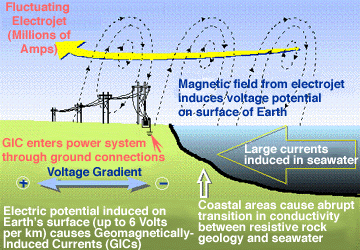Click on image for full size
Direct Current (DC) & Alternating Current (AC) Electricity
There are two types of electrical currents that can flow through wires: direct current (DC) and alternating current (AC).
Direct current (DC) flows in the same direction all the time through an electric circuit. Electrons flow continuously through the circuit from the negative terminal of the battery to the positive terminal. Even when no current is flowing through the wire, the electrons in the wire are moving at speeds up to 600 miles (1,000 kilometers) per second but in random directions because the wire has a finite temperature. Since one electron is moving back along the wire at the same time another is moving forward, no net charge is transported along the wire. If a battery is hooked to the ends of the wire, the electrons get pushed all in the same direction along the wire. The speed of the electrons along the wire is less than an inch (few millimeters) per second. So any single electron takes a long time to get all the way around the circuit. There are so many electrons that they bump into one another, like dominoes, and there is a net shift of electric charges around the circuit that can happen at speeds up to the speed of light.
The outlets in our homes provide alternating current (AC). 60 times every second the electrons in the wire change direction. The electrical devices we use don't care which direction the electrons are moving, since the same amount of current flows through a circuit regardless of the direction of the current.
Electric power distribution networks which deliver electricity to our homes are set up to handle alternating current electricity. Space weather storms can cause flows of direct current electricity in the electrical power grid. Since the grid was designed to used AC electricity but not DC electricity, the space weather induced direct currents can damage or destroy some types of equipment, such as voltage transformers.













